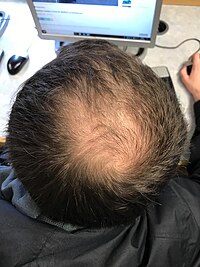
Photo from wikipedia
Children and adolescents with chronic cutaneous conditions are at risk of experiencing adverse psychosocial effects such as anxiety, depression, and loneliness. The well-being of these children's families may also be… Click to show full abstract
Children and adolescents with chronic cutaneous conditions are at risk of experiencing adverse psychosocial effects such as anxiety, depression, and loneliness. The well-being of these children's families may also be impacted by their child's condition. It is important for the quality of life of patients and their families to better understand the psychosocial impact caused by pediatric dermatologic conditions and interventions that help mitigate these effects. This review summarizes the psychological impact of the common pediatric dermatological disorders, vitiligo, psoriasis, and alopecia areata, on children and their caregivers. Studies examining quality of life, psychiatric conditions, and other measures of psychosocial impact in children and caregivers, as well as those evaluating the effectiveness of interventions aimed at addressing psychosocial effects, were included. This review highlights the increased risk that children with these conditions have in experiencing adverse psychosocial effects including quality of life impairment, psychological pathology, and social stigmatization. In addition, the specific risk factors within this population that are associated with increased negative effect such as age and severity of disease are discussed. This review demonstrates a need for increased support of these patients and their families and additional research on the effectiveness of current interventions.
Journal Title: Dermatology online journal
Year Published: 2023
Link to full text (if available)
Share on Social Media: Sign Up to like & get
recommendations!